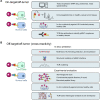TCR-engineered T cell therapy in solid tumors: State of the art and perspectives
- PMID: 36791198
- PMCID: PMC9931212
- DOI: 10.1126/sciadv.adf3700
TCR-engineered T cell therapy in solid tumors: State of the art and perspectives
Abstract
T cell engineering has changed the landscape of cancer immunotherapy. Chimeric antigen receptor T cells have demonstrated a remarkable efficacy in the treatment of B cell malignancies in hematology. However, their clinical impact on solid tumors has been modest so far. T cells expressing an engineered T cell receptor (TCR-T cells) represent a promising therapeutic alternative. The target repertoire is not limited to membrane proteins, and intrinsic features of TCRs such as high antigen sensitivity and near-to-physiological signaling may improve tumor cell detection and killing while improving T cell persistence. In this review, we present the clinical results obtained with TCR-T cells targeting different tumor antigen families. We detail the different methods that have been developed to identify and optimize a TCR candidate. We also discuss the challenges of TCR-T cell therapies, including toxicity assessment and resistance mechanisms. Last, we share some perspectives and highlight future directions in the field.
Figures



References
-
- J. A. Beaver, R. Pazdur, The wild west of checkpoint inhibitor development. N. Engl. J. Med. 386, 1297–1301 (2022). - PubMed
-
- M. Mallet, R. E. Boulos, V. Alcazer, P. Bonaventura, Y. Estornes, N. Chuvin, S. Depil, Tumour burden and antigen-specific T cell magnitude represent major parameters for clinical response to cancer vaccine and TCR-engineered T cell therapy. Eur. J. Cancer Oxf. Engl. 171, 96–105 (2022). - PubMed
-
- S. A. Rosenberg, P. Spiess, R. Lafreniere, A new approach to the adoptive immunotherapy of cancer with tumor-infiltrating lymphocytes. Science 233, 1318–1321 (1986). - PubMed
-
- S. A. Holstein, M. A. Lunning, CAR T-cell therapy in hematologic malignancies: A voyage in progress. Clin. Pharmacol. Ther. 107, 112–122 (2020). - PubMed
Publication types
MeSH terms
Substances
LinkOut - more resources
Full Text Sources
Other Literature Sources
Medical

